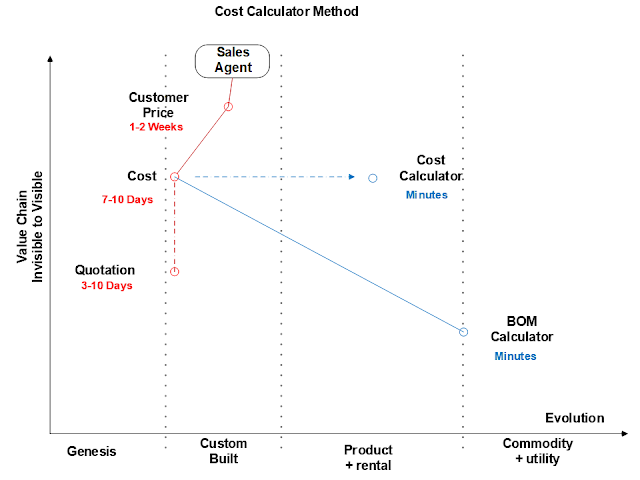The question was, if we understand the BOM, "Can we get to ROM Cost quicker?"
 |
| 5. Cost Calculator |
The good thing, if it is possible to create a BOM Calculator, most of the business logic is understood well enough to introduce the concept of Cost with the same (or similar) business logic. The reverse is also true, we just needed a starting point.
In Figure 5, we're evolving a Cost Calculator as a product of the BOM Calculator output. It is most assuredly in the Product category because it requires a product like update on a regular interval with the partner/vendor to maintain currency with their cost changes.
In Figure 6, we've created the new Cost method.
 |
| 6. New Cost Method |
The problem, it is unlikely to be as exact as the Quotation step, but fine for ROM review. Providing we can live with small fluctuation between the Cost Calculator and the Quotation, everything should be fine. Just make absolutely sure you understand completely the cost tolerance requirements.
 |
| 7. Optimization Method |
The Question for the Cost Calculator, "Is 1 large widget more cost effective than 2 medium widgets or even 4 small widgets?"
Consider the scenario where the product is a combination of labor, hardware and software licensing. Optimization of the Calculators (a Calculator of Calculators, if you will) provides the means to create a deeper awareness of the product as well as a mechanism for Sizing appropriately for the need with cost in mind.
 |
| 8. New ROM and BOM tool |
The Question, "Can we get to Customer Price quicker with better awareness?"
In the mapping exercise, we could very well have started with this question as it would be the most customer centric pursuit. I'm not entirely sure it would have changed the path we followed, but I'm relatively certain it would have been a more daunting starting point.
 |
| 9. New Costing and Pricing Method |
It's obvious that a Calculator for pricing solves this problem the most expediently.
At this point, we've achieved the knowledge necessary to create calculators for the change in process steps. We can also use those calculators to feed the Quotation requirements, potentially shortening that process step in Final Pricing.
The big win, we've moved the Sales Agent's view of the process from Custom Build to Product and improved his time to respond to the customer.
The overall process, from start to finish goes like this:
Customer Input -> ROM and BOM Calculator (as many times as Customer Input changes) -> Feed the Sizing from the ROM and BOM Calculator to Quotation -> Run the Quotation(s) through the Pricing Tool -> Sales Agent happiness
This Wardley Mapping exercise ended up being mostly about convenience, a bit about standardization. How do you execute an On-Demand set of actions that would normally take between 22 and 44 days, in the shortest time possible?
As always, I'm interested in your feedback. Find me on Twitter @abusedbits

No comments:
Post a Comment